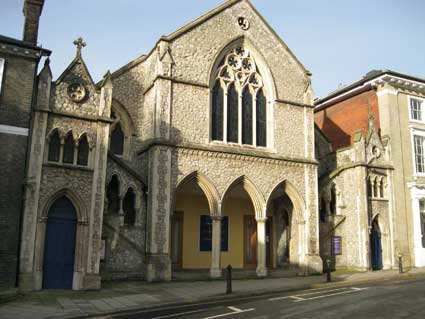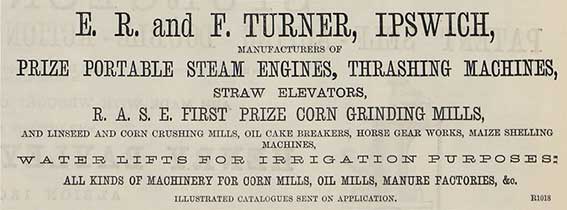Museum
Street Methodist Church
(from corsets to chapel)
 <2021
<2021

In the upper part of Museum Street
opposite the original Ipswich Museum (today Arlington's Restaurant) and
the Arcade Street junction stands the
rather handsome stone frontage of the Methodist Church:
'FOUNDATION STONE
OF
WESLYAN CHAPEL
LAID JUNE 20
1860'


This site in Museum Street was purchased for £1,300 in March
1860. The foundation stone, to be found at the foot of the square
pillar to the right of the three central arches, was laid my Mr William
Pretty on the date shown with a silver trowel which is still on display
in the church. The building opened for worship on Wednesday 27 March
1861. The church organ, a gift from William Pretty came from St Lawrence Church in Dial Lane. William
Pretty's name appears on other buildings in the town (including Alan Road Methodist Church, see below
for more information). A Minister's House was erected at the rear of
the church and is still in use as Church Circuit Office with a flat on
the first floor. Many improvements have been made since the opening in
1861, notably the transformation in 1959 when the whole body of the
church was reversed and a new stained glass window was installed.
Chairs have since replaced pews. The main entrance is now in Black
Horse Lane (home of the William Paul
Tenement Trust lettering) and the space is also used for talks and
other events.
The Listing (Grade II) text reads: "Designed by Frederick J.
Barnes, in the Gothic Revival style. Kentish rag stone with ashlar
dressings facade with brick rear. Slate roof with moulded coped gables
and finials. Chamfered plinth. Street facade has gabled west end
incorporating porch and side wings. Central triple pointed arch loggia,
with moulded arches supported on quatrefoil pillars and matching
responds. Corner clasping buttresses with gabled tops. Above a single
4-light, pointed arch window with elaborate geometrical tracery and a
chamfered cill band. Above again a small circular window with trefoil
tracery. Eitherside are single staircases rising outwards and with
triple arched stepped arcades supported on small pillars. Beyond are
slightly projecting gabled side wings with pointed arch doorways in
moulded surrounds and 6 panel doors with trefoil fan-lights. Above
small triple pointed arch arcades, then a chamfered band and a gable
containing a blind trefoil, and surmounted by a cross finial."
William Pretty
In researching William Pretty, we came across a talk by Roger
Kennell, the local history recorder at Hadleigh. We can do no
better than add a paraphrased version of the text, with
acknowledgement.
William Pretty built England’s first corset factory, which later
became the largest, producing a great range of corsets in innovative
styles which were exported all over the world. He started in a small
way, being born in 1812, the son of a draper and tailor from Bacton. He
left school at 13 to make his way in business, and obtained an
apprenticeship with John Footman, a draper in Stowmarket. In 1815
Footman set up a draper’s in the Butter
Market, Ipswich and in 1834
joined up with William Pretty and Alexander Nicholson to form the
company Footman,
Pretty and Nicholson at fine new premises in Westgate Street which
they named “Waterloo House”. This prominently lettered building appears
in old photographs and postcards of the Cornhill.
William Pretty was a philanthropist who donated several sums of money
from his profits to good causes in and around Ipswich, including the
building and re-furbishing of local churches. In 1842 he married and
had a son, William Junior, who joined him in the family business.
William Junior was a modern man of his time. He loved sports and it is
said that he was the first man in Ipswich to play tennis or to go
ice-skating. He was a forward thinker in business too, and he often
argued with his
father about the way things should be run. He started at the bottom in
the firm, working on the shop counter, to learn the trade thoroughly.
Footman, Pretty and Nicholson was already a big name in huge premises,
making their name as 'stay' manufacturers for girls and women of all
ages. During the Victorian and Edwardian eras the hourglass figure
was in fashion, and every woman wanted to keep up with the trend, which
was only possible with the wearing of corsets. These were manufactured
at the rear of Waterloo House in a large factory, using fabrics such as
linen or cotton containing strips of shaped whalebone, horn or rustless
Zairoid which would not bend or break, thus maintaining the desired
hourglass figure of the wearer.
After visiting America on business and speaking to a German
manufacturer in the same trade William Junior found a huge market for
his product. He wrote to his wife that he could have sold orders worth
over £10,000, but that the Ipswich factory did not have enough workers
to produce this large number of corsets. He decided to ask his father
to build a new factory at the rear of the existing one in Ipswich, and
in 1881 they opened the new building, made with best white Suffolk
bricks, in Crown Street. Many will remember the long building with its
high chimney which stood on the site now occupied by the car park at
the rear of Debenhams and Marks & Spencer. A bridge over that
section of Tower Ramparts featured the compnay lettering and appears on
our collage of lost lettering. Much to
William’s disappointment, however,
they could not find enough cheap labour in the form of young women to
fill the entire factory. To solve this problem, William Junior began
opening outpost factories close to railway stations all over Suffolk,
Norfolk and Essex. The Ipswich factories now employed men who cut out
the fabric patterns, which were then put on the train and sent to the
outpost factories to be sewn together to make the finished corsets.
These were sent back to Ipswich for boxing and delivering. Corsets were
always sold in decorative boxes, so to complete the process William
Junior set up his own box-making and print works, thus making the whole
production-line an in-house operation.
Sadly for the Prettys, the era of wearing corsets gradually came to an
end. Factors like the women’s suffrage movement, the Dress Reform
Society, the new roles of women in war work during the First World War
and a paper written by the British Medical Association all discouraged
women from strapping themselves up tightly for the sake of
fashion. Corset factories began to make rayon and silk underwear,
Liberty bodices and roll-ons. In 1930 William Pretty and Sons went into
liquidation. R. & W.H. Symingtons of Market Harborough bought the
factory and started new brands such as Avro Corsetry and Liberty
Foundations. They were bought up by Courtauld’s in 1968, but eventually
the premises shut down in 1982 after 100 years.
(http://capelladies.com/2012/04/05/apr-5th-william-pretty-suffolk-corset-manufacturers/)
For a note on other Ipswich stay-makers and corsetiers, see E. Brand & Sons.
Turner's of Ipswich columns
 2016
images
2016
images
The galleries of the interior of the Methodist Church are
supported on cast iron columns bearing the name of the foundry:
'TURNER'S IPSWICH.'

This would be E.R. & F. Turner's engineering firm in Foundry
Lane, which runs between St Peter's Wharf and College Street. They
also operated the Greyfriars Works. One of the many
engineering works in Ipswich and founded in 1837, Turner's eventually
took over Bull Motors
of Stowmarket and as engineering declined the electric motor business
became dominant. Bull Motors moved to a site next to the Celestion
loudspeaker factory, just off Foxhall Road, Ipswich and operated there
until at least 2000.
 January
1872 advertisement
January
1872 advertisement
For more information on E.R. & F. Turner, Grace's
Guide (see Links) have details and images.
See also the Turner cast iron columns in Christ Church
URC/Baptist in
Tacket Street which shares the same designer, by Frederick J. Barnes.
The Methodist Church stands opposite the original Ipswich
Museum designed by Christopher Fleury; today it is Arington's
Restaurant.
Home
Please email any comments and contributions by clicking here.
Search Ipswich
Historic Lettering
©2004 Copyright
throughout the Ipswich
Historic Lettering site: Borin Van Loon
No reproduction of text or images without express written permission
 <2021
<2021



 2016
images
2016
images
 January
1872 advertisement
January
1872 advertisement